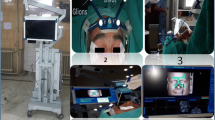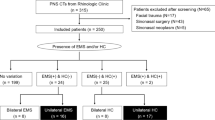Abstract
The endoscope has revolutionized the diagnosis and treatment of diseases of the nose and paranasal sinuses. Endoscopic sinus surgery (ESS), like all minimally invasive surgery, is designed to combine an excellent outcome with minimal patient discomfort. Successful outcome with minimal complications can only be achieved with good knowledge of the endoscopic anatomy, appropriate training in the procedure and the understanding of the anatomical variations. The intraoperative complications of ESS are bleeding and injury to surrounding structures commonly the orbital structures and fovea ethmoidalis. This is a hospital based prospective observational study with an objective to define the distribution of Keros classification of the depth of olfactory fossa and its asymmetrical distribution rates based on Keros type. Prospective study in a tertiary rural based hospital. 100 patients above the age of 10 years from October 2013 to March 2015 for a period of one year six months undergoing endoscopic sinus surgery in the Department of ENT, P.E.S. Institute of Medical Sciences and Research, Kuppam were chosen randomly. The data was collected from these patients who will met the inclusion criteria of the study and before undergoing endoscopic sinus surgery by subjecting them to CT scan of paranasal sinuses. It is observed that a total of 100 patients had been studied in which the mean age of the population is 36.65 + 13.36 years. Youngest patient was 12 years old and eldest patient was 70 years old. Among the patients 50(50%) were males and remaining 50(50%) were females with a female to male ratio is 1:1. In the present study, the depth of olfactory fossa ranged from 2.1 to 8.3 mm inclusive of both sides in 200 CT images with a mean height of 5.21 mm. Of the 200 sides measured, the distribution of Keros classification is as the following—Keros type I 39(19.5%), Keros type II 143(71.5%) and Keros type III 18(9%) sides. Based on these observations, type II is the most common Keros type prevalent followed by type 1 Keros type and the least prevalent is the type III Keros type in the studied population. In the present study, on considering sides separately, the right side olfactory fossa depth ranged from 2.1 to 8.3 mm with a mean height of 5.43 mm and the left side olfactory fossa depth ranged from 2.1 to 8.1 mm with a mean height of 4.98 mm. On the right side, of 100 sides measured, the distribution of Keros classification is as the following—Keros type I 19(19%), Keros type II 68(68%) and Keros type III 13(13%) sides. On the left side, of 100 sides measured, the distribution of Keros classification is as the following—Keros type I 25(25%), Keros type II 70(70%) and Keros type III 5(5%) sides. Based on these observations, type II is the most common Keros type prevalent followed by type 1 Keros type and the least prevalent is the type III Keros type in the studied population on both sides. In the present study, out of 100 patients 23 patients were having asymmetric olfactory fossa between right and left sides based on Keros type, where as remaining 77% had symmetric Keros type on right and left sides. Out of 23 patients, 16 patients were having lower or deep olfactory fossa on right side, where as remaining 7 patients were having lower or deep olfactory fossa on left side. Based on these observations, a lower or deep ethmoid roof occurred more frequently on the right side than on the left side. Wilcoxon matched pair signed rank test is applied to see the significant difference between depth of right and left olfactory fossae. Since P value is < 0.001 the depth of olfactory fossa is significantly different from each other. The present study presents a precise, quantitative analysis of the olfactory fossa and ethmoid roof position as well as individual asymmetry. This information may be useful during pre-operative evaluation of CT images, as well as intraoperatively. The surgeon’s understanding of the anatomy of a patient’s ethmoid roof and its possible variations is crucial for countering possible complication risks during endoscopic sinus surgery.
Similar content being viewed by others
References
Luong A, Marple BF (2006) Sinus surgery: indications and techniques. Clin Rev Allergy Immunol 30:217–222
McMains KC (2008) Safety in endoscopic sinus surgery. Curr Opin Otolaryngol Head Neck Surg 16:247–251
Ulualp SO (2008) Complications of endoscopic sinus surgery: appropriate management of complications. Curr Opin Otolaryngol Head Neck Surg 16:252–259
Kennedy DW, Shaman P, Han W, Selman H, Deems DA et al (1994) Complications of ethmoidectomy: a survey of fellows of the American academy of otolaryngology-head and neck surgery. Otolaryngol Head Neck Surg 111:589–599
Ohnishi T, Tachibana T, Kaneko Y, Esaki S (1993) High-risk areas in endoscopic sinus surgery and prevention of complications. Laryngoscope 103:1181–1185
Ohnishi T, Yanagisawa E (1995) Lateral lamella of the cribriform plate—an important high-risk area in endoscopic sinus surgery. Ear Nose Throat J 74:688–690
Stammberger H, Wolf G (1988) Headaches and sinus disease: the endoscopic approach. Ann Otol Rhinol Laryngol 97:3–23
Wigand ME (1990) Endoscopic surgery of the paranasal sinuses and anterior skull base. Georg Thieme Verlag, Stuttgart
Stankiewicz JA (1989) Complications of endoscopic intranasal ethmoidectomy: an update. Laryngoscope 99:686–690
Maniglia AJ (1989) Fatal and major complications secondary to nasal and sinus surgery. Laryngoscope 99:276–283
Freedman HM, Kern EB (1979) Complications of intranasal ethmoidectomy. Laryngoscope 89:421–434
Lund VJ, Mackay IS (1994) Outcome assessment of endoscopic sinus surgery. Proc R Soc Med 87:70–72
Cumberworth VL, Sudderick RM, Mackay IS (1994) Major complications of functional endoscopic sinus surgery. Clin Otolaryngol 19:248–253
Hopkins C, Browne JP, Slack R, Lund V, Topham J, Reeves BR et al (2006) Complications of surgery for nasal polyposis and chronic rhinosinusutis: the results of a national audit in England and Wales. Laryngoscope 116:1494–1499
Maran AGD, Lund VJ, Mackay IS, Wilson J (1993) Endoscopic sinus surgery. Report of Royal College of Surgeons of Edinburgh, 15 Jan 1993
Bothwell MR, Piccirillo JF, Lusk RP, Ridenour BD (2002) Long-term outcome of facia growth after functional endoscopic sinus surgery. Otolaryngol Head Neck 126:628–634
Lund VJ, Neijens H, Clement P, Lusk R, Stammberger H (1995) The treatment of chronic sinusitis: a controversial issue. Int J Pediatr Otorhinolaryngol 32:S21–S35
Keros P (1962) On the practical value of differences in the level of the lamina cribrosa of the ethmoid. Z Laryngol Rhinol Otol 41:809–813
Basak S, Karaman CZ, Akdilli A, Mutlu C, Odabasi O, Erpek G (1998) Evaluation of some important anatomical variations and dangerous areas of the paranasal sinuses by CT for safer endonasal surgery. Rhinology 36:162–167
Gauba V, Saleh GM (2006) Radiological classification of anterior skull base anatomy prior to performing medial orbital wall decompression. Orbit 25:93–96
Stammberger H (1993) Endoscopic anatomy of lateral wall and ethmoidal sinuses. Mosby-Year Book, St. Louis, pp 13–42
Nair S (2012) Importance of ethmoidal roof in endoscopic sinus surgery. Sci Rep 1:251
Souza SA, de Souza MMA, Idagawa M, Wolosker ÂMB, Ajzen SA (2008) Computed tomography assessment of the ethmoid roof: a relevant region at risk in endoscopic sinus surgery. Radiol Bras 41(3):143–147
Ali A, Kurien M, Shyamkumar NK (2005) Anterior skull base: high risk areas in endoscopic sinus surgery in chronic rhinosinusitis: a computed tomographic analysis. Indian J Otolaryngol Head Neck Surg 57(1):5–8
Bista M, Maharjan M, Kafle P, Shreshta S (2010) Computed tomographic assessment of lateral lamella of cribriform plate and comparison of depth of olfactory fossa. J Nepal Med Assoc 49(178):92–95
Kaplanoglu H, Kaplanoglu V, Dilli A, Toprak U, Hekimoğlu B (2013) An analysis of the anatomic variations of the paranasal sinuses and ethmoid roof using computed tomography. Eur J Med 45:115
Lebowitz RA, Terk A, Jacobs JB, Holliday RA (2001) Asymmetry of the ethmoid roof: analysis using coronal computed tomography. Laryngoscope 111:2122–2124
Dessi P, Moulin G, Triglia JM, Zanaret M, Cannoni M (1994) Difference in the height of the right and left ethmoid roofs. J Laryngol Otol 108:261–262
Şahin C, Yılmaz YF, Titiz A, Özcan M, Özlügedik S, Ünal A (2007) Analysis of ethmoid roof and cranial base in Turkish population. KBB ve BBC Dergisi 15:1–6
Arikan OK, Unal B, Kazkayasi M, Koc C (2005) The analsis of anterior skull base from two different perspectives: coronal and reconstructed sagittal computed tomography. Rhinology 43:115–120
Dessi P, Castro F, Triglia JM, Zanaret M, Cannoni M (1994) Major complications of sinus surgery: a review of 1192 procedures. J Laryngol Otol 108:212–215
Bumm K, Heupel J, Bozzato A, Iro H, Hornung J (2009) Localization and infliction pattern of iatrogenic skull base defects following endoscopic sinus surgery at a teaching hospital. Auris Nasus Larynx 36(6):671–676
Glaser AY, Hall CB, Uribe JI, Fried MP (2005) The effects of previously acquired skills on sinus surgery simulator performance. Otolaryngol Head Neck Surg 133(4):525–530
Wigand ME (2008) Endoscopic surgery of the paranasal sinuses and anterior skull base. Georg Thieme, New York
Author information
Authors and Affiliations
Corresponding author
Ethics declarations
Conflict of interest
The authors have no conflict of interests, financial or otherwise.
Ethical Approval
All procedures performed in studies involving human participants were in accordance with the ethical standards of the institutional and/or national research committee and with the 1964 Helsinki declaration and its later amendments or comparable ethical standards.
Rights and permissions
About this article
Cite this article
V., A.M., Santosh, B. A Study of Clinical Significance of the Depth of Olfactory Fossa in Patients Undergoing Endoscopic Sinus Surgery. Indian J Otolaryngol Head Neck Surg 69, 514–522 (2017). https://doi.org/10.1007/s12070-017-1229-8
Received:
Accepted:
Published:
Issue Date:
DOI: https://doi.org/10.1007/s12070-017-1229-8




